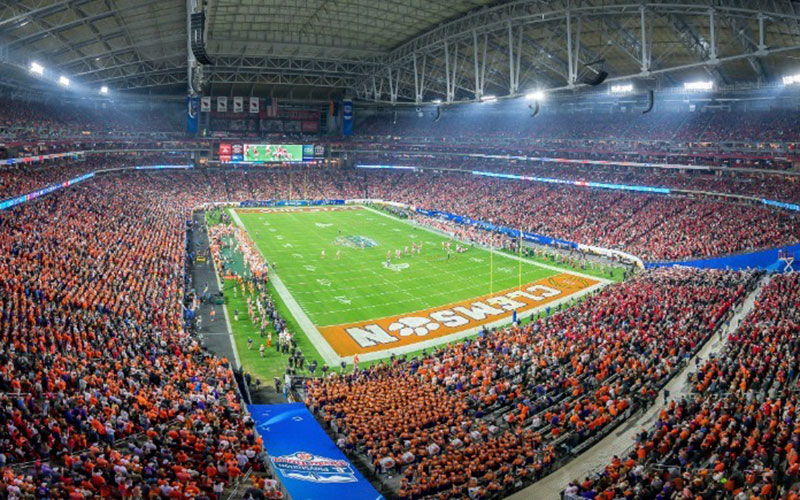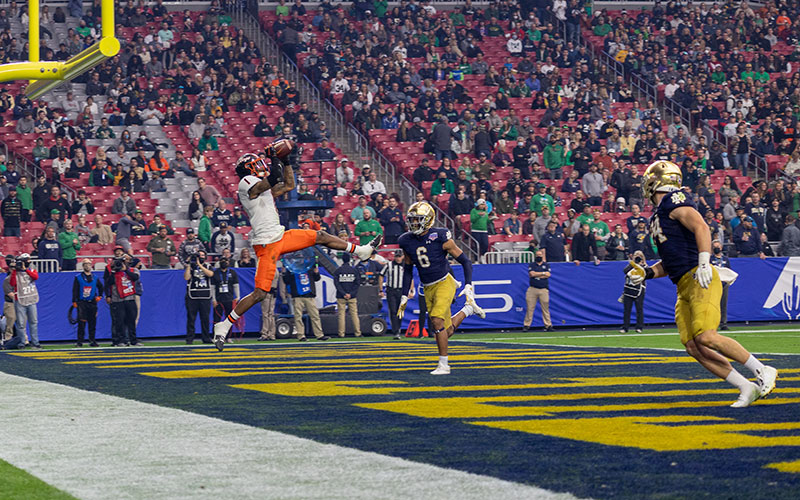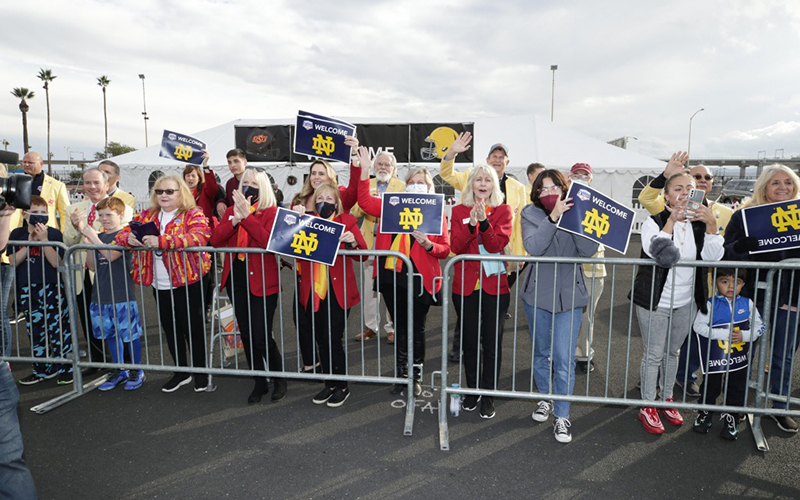PHOENIX – Talk in college football circles in recent years has centered on the possible expansion of the College Football Playoff from four teams to 12, a topic that is especially important to organizers of the PlayStation Fiesta Bowl.
However, despite eight months of talks, 10 FBS commissioners and Notre Dame athletic director Jack Swarbrick, who control the playoff format, could not reach a consensus on a format for an expanded playoff.
To the disappointment of many college football fans, the group agreed to keep the four-team format through the 2025 College Football Playoff. The Fiesta Bowl, along with the other New Year’s Six bowl games, were patiently awaiting the announcement.
Expansion appears to be inevitable and will determine the setting and importance of the bowl games involved. Whatever format the commissioners decide upon, Fiesta Bowl officials say their game will adjust and evolve as it has so often in the past.
“The conversation is no longer if there’s going to be expansion and whether or not there should be,” Fiesta Bowl Executive Director Mike Nealy said. “It’s definitely going to happen and is just a matter of time.”
Currently, the New Year’s six bowls – the Fiesta, Rose, Cotton, Orange, Peach and Sugar – are part of a three-year rotation to play host to national semifinal playoff games. Those not involved in the semifinal games host other top teams in a high-profile, non-playoff matchup.
It remains unclear how many teams will be in an expanded playoff, but most speculation has centered on a possible 12-team field.
However, there are potential roadblocks. Bowl games are built on traditions to which they stubbornly stick. The Rose Bowl, for instance, is played on New Year’s Day at 2 p.m. EST, a time slot that played a part in the Fiesta Bowl’s rapid growth.
The Fiesta Bowl was not played on New Year’s Day until 1982, when the Sugar Bowl moved its kickoff to the evening to attract better television ratings. The Fiesta petitioned to move into the daytime Sugar Bowl slot opposite the Cotton Bowl as a lead-in to the Rose Bowl on NBC, a bold move that put the Fiesta on equal footing with the so-called Big Four of college bowl games at the time, the Rose, Cotton, Sugar and Orange.
The games are often accompanied by other events, such as parades and charitable events. Navigating these obstacles is another aspect of any proposed expansion plan.
“Understanding the tradition that comes with some of these games is vital,” said Brett Daniels, senior director of communications and branding for the CFP. “The bowl system, especially the Fiesta and Rose Bowl, are a crucial part of the college football tradition.
“Maintaining that legacy is definitely something that the College Football Playoff committee is considering while we are exploring ways to build and expand the playoff.”
The Fiesta Bowl, while rich in tradition, is a flexible event, as that move to Jan. 1 demonstrated back in 1982. It also was among the first bowl games to sign a name sponsorship when it became the Sunkist Fiesta Bowl in 1986.
The game also showed its ability to adjust during the 1986 college football season, arranging a national championship matchup of two independent programs at the time, Miami and Penn State.
The Fiesta, which had no conference affiliation in those days, was the only game that could arrange a game between the top-ranked Hurricanes and the second-ranked Nittany Lions. The game was moved to prime time on Jan. 2, 1987, to attract the largest possible audience and a record 21.9 million households tuned into NBC’s broadcast of Penn State’s upset victory.

The Fiesta Bowl tends to draw big crowds because of the high profile game and warmer weather in Arizona. (Photo courtesy of the Fiesta Bowl)
Since then, the Fiesta Bowl has been a player in college football’s various national championship systems by remaining nimble.
The game moved from Sun Devil Stadium in Tempe to what is now State Farm Stadium in Glendale in 2007, and over the last 14 years, it has been played on eight different dates. And Fiesta Bowl organizers are willing to remain flexible in the future in order to make an expanded playoff work.
“We’re open to hosting the game on any date, as that week surrounding the New Year is such a great time in general,” Nealy said. “The Fiesta Bowl even used to be played on Christmas Day. The target will continue to be right around New Year’s, but we are happy to accommodate whenever the game is needed for fans, players, and personnel to get into Arizona.”
Daniels said flexibility will be considered when the time comes to iron out the details. Accommodations will have to be made on both sides, from the FBS commissioners and the bowl games.
At the end of the day, the Fiesta Bowl is likely to remain on the national stage in any playoff format that comes after 2025, showcasing the beauty of Arizona. And that’s critical to football, said Jon Wilner, author of the Pac-12 Hotline.
“The Fiesta Bowl is a very big deal to West Coast football,” Wilner said. “There’s really only three big games out west. It’s also important to the Pac-12 because it provides a very favorable geographical location. It’s easier for fans to get to, and it is in the Pac-12’s natural recruiting region. Having the Fiesta Bowl thriving long-term is huge for Western college football.”
Arizona’s temperate winter weather and unique desert landscape are also a big draw to football fans from other regions of the country.
Although the 2022 game wasn’t part of the playoff, Notre Dame and its large following still descended on the Valley and were joined by droves of Oklahoma State fans after their team’s strong regular season.
The 2023 game promises to be packed again when the Fiesta Bowl plays host to its third CFP semifinal.
The first two CFP semifinals at the Fiesta Bowl each featured matchups of Clemson and Ohio State. While local college football fans are probably hoping to see new teams play in their backyard next time, Nealy and the Fiesta Bowl committee consider the situation a “win-win.”
“If it is Ohio State and Clemson again, we would love to welcome them back and put on a great show for another sold out crowd, but variety would be awesome as well,” Nealy said. “When you’re at that level and dealing with the top-four teams in the country, regardless if it’s a repeat or not, you’re going to have a great game. So we’d welcome any team.”
Because it’s a national semifinal game, the next Fiesta Bowl will fall on Dec. 31, 2022, at State Farm Stadium.
For now, that’s the focus of the Fiesta Bowl’s organizers and its thousands of volunteers. If the FBS power brokers come to an agreement on playoff expansion, the Fiesta Bowl will be ready, as nimble as ever.



